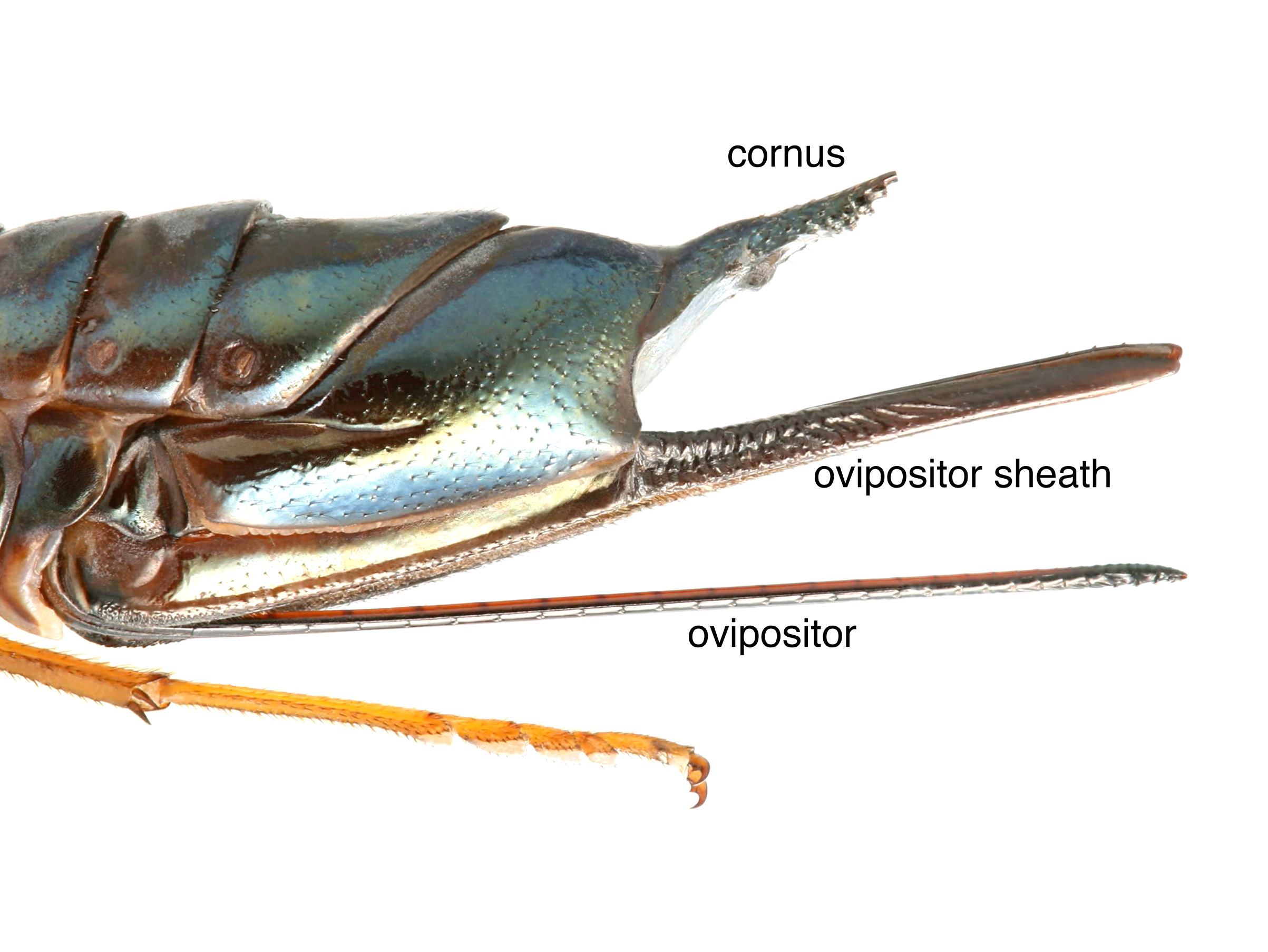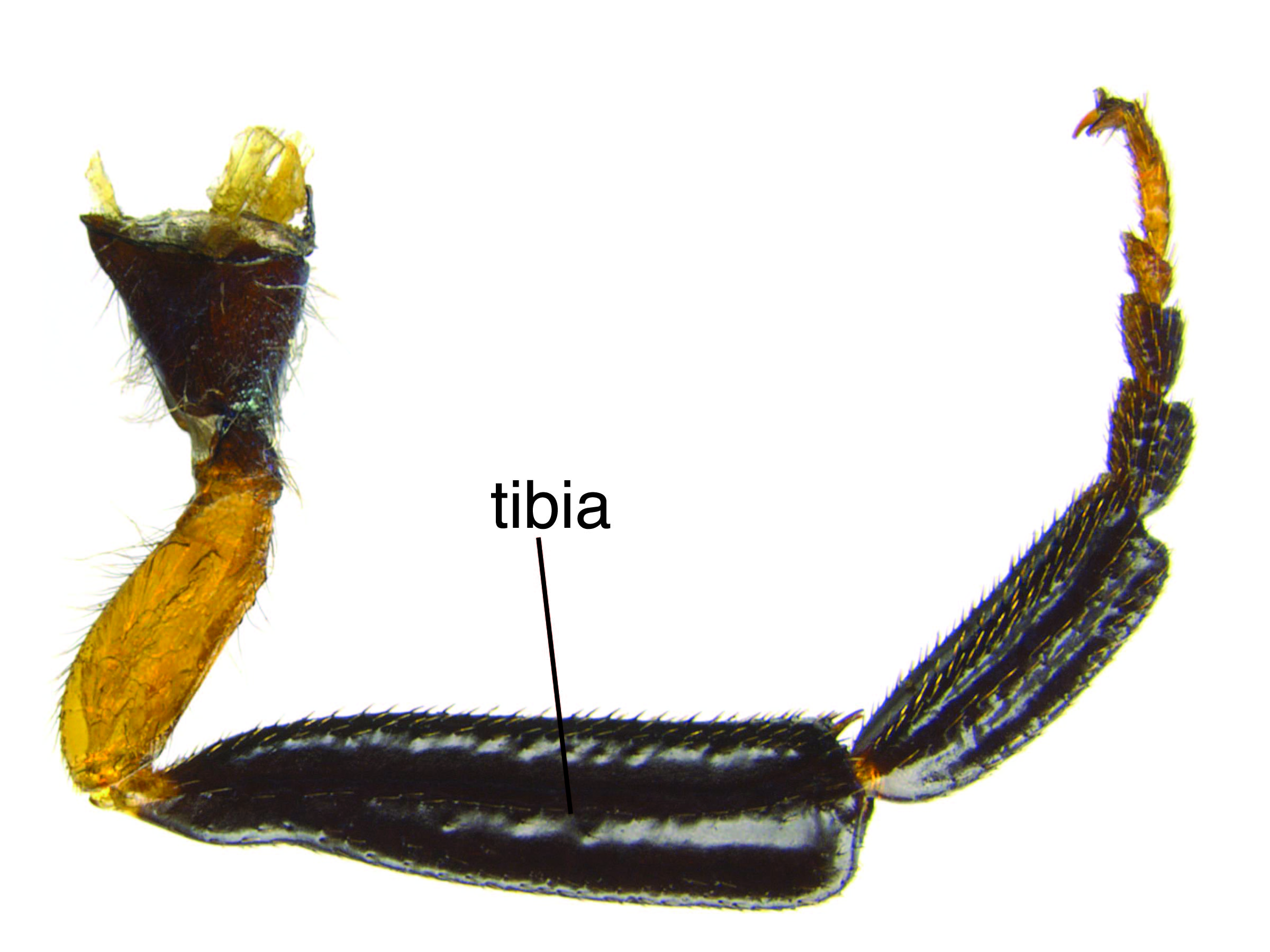Family: Cephidae
Family common name: stem sawflies
Subfamily: Cephinae
Genus: Cephus Latreille, 1803
Subgenera: none
The Cephidae are commonly known as “stem sawflies” because larvaelarva:
the immature stage of holometabolous insects
 feed and live within the stems of small herbaceousherbaceous:
feed and live within the stems of small herbaceousherbaceous:
describing a plant that does not have a woody stem and is often close to the ground; e.g., grasses, forbs, and vegetable plants
and woody plants. Many are considered pests as this feeding behavior can damage or kill the plant host (Shanower and Hoelmer 2004Shanower and Hoelmer 2004:
Shanower TG and Hoelmer KA. 2004. Biological control of wheat stem sawflies: past and future. Journal of Agricultural and Urban Entomology 21 (4): 197-221.).
Stem sawflies of the genus Cephus are generally slender, with slightly laterally compressed cylindrical bodies. They have a black head and black body with yellow markings. There is a slight constriction at the second abdominal segment, giving it the gestalt of a wasp (Middlekauff 1969Middlekauff 1969:
Middlekauff WW. 1969. The cephid stem borers of California (Hymenoptera: Cephidae). Bulletin of the California Insect Survey 2: 1-25.). They are medium-sized, usually about 1 cm in length, and slow flyers, so it is easy to observe them where they occur (Ivie 2001Ivie 2001:
Ivie MA. 2001. On the geographic origin of the wheat stem sawfly (Hymenoptera: Cephidae): a new hypothesis of introduction from northeastern Asia. American Entomologist 47 (2): 84-97.).
Worldwide, there are 40 described species, restricted to the Northern Hemisphere. Diversity is low in North America, with only two known species (Taeger et al. 2010Taeger et al. 2010:
Taeger A, Blank SM, and Liston AD. 2010. World Catalog of Symphyta (Hymenoptera). Zootaxa 2580: 1-1064.).
A key to Californian species of Cephus is included in Middlekauff 1969Middlekauff 1969:
Middlekauff WW. 1969. The cephid stem borers of California (Hymenoptera: Cephidae). Bulletin of the California Insect Survey 2: 1-25..
 and mandibles asymmetrical, larger on the right side (Ries 1937Ries 1937:
and mandibles asymmetrical, larger on the right side (Ries 1937Ries 1937: beyond sixth or seventh segment (Ries 1937Ries 1937:
beyond sixth or seventh segment (Ries 1937Ries 1937: sheath tapering evenly to the apexapex:
sheath tapering evenly to the apexapex:Cephus can be confused with other Cephidae, especially Trachelus and Calameuta which were once treated as synonyms. They can be distinguished from Trachelus by the lack of bristled pits on sternitesternite:
a sclerotized segment of the abdominal sternum
 7 and 8 of the male, from Calameuta by the presence of long modified setaeseta:
7 and 8 of the male, from Calameuta by the presence of long modified setaeseta:
hair-like structure
on sternitesternite:
a sclerotized segment of the abdominal sternum
 8 of the male, and from other genera in the family presence of preapicalpreapical:
8 of the male, and from other genera in the family presence of preapicalpreapical:
close to, but anterior to, the apex
 spurs on the hind tibiaetibia:
spurs on the hind tibiaetibia:
the fourth segment of the leg, between the femur and the tarsus
 , flagellomereflagellomere:
, flagellomereflagellomere:
A segment of the flagellum of the antenna
 3 subequal to 4, and the distinctly clavateclavate:
3 subequal to 4, and the distinctly clavateclavate:
club-like, thickening toward the tip; often used to describe antennae
 antennaeantenna:
antennaeantenna:
the sensory organ emerging from the front of the head, usually between the compound eyes and above the clypeus; includes the flagellum, scape and pedicel
 beginning past the midpoint (Ries 1937Ries 1937:
beginning past the midpoint (Ries 1937Ries 1937:
Ries DT. 1937. A revision of the Nearctic Cephidae (Hymemoptera: Tenthredinoidea). The American Entomological Society 63 (3): 259-327., Middlekauff 1969Middlekauff 1969:
Middlekauff WW. 1969. The cephid stem borers of California (Hymenoptera: Cephidae). Bulletin of the California Insect Survey 2: 1-25., Smith and Schiff 2005Smith and Schiff 2005:
Smith DR and Schiff NM 2005. A new western Nearctic species of Calameuta Konow (Hymenoptera: Cephidae). Proceedings of the Entomological Society of Washington, 107 (4): 864-868.).
Cephus pygmaeus is a pest of wheat crops in its native range of Eurasia, and in North America, where it was introduced in the 1880s (Shanower and Hoelmer 2004Shanower and Hoelmer 2004:
Shanower TG and Hoelmer KA. 2004. Biological control of wheat stem sawflies: past and future. Journal of Agricultural and Urban Entomology 21 (4): 197-221.). Infestations in the Northeast United States have historically been as high as 45% in cereal and grain crops. This species may also be competing with and displacing another exotic stem sawfly, Trachelus tabidus in this same range (Middlekauff 1969Middlekauff 1969:
Middlekauff WW. 1969. The cephid stem borers of California (Hymenoptera: Cephidae). Bulletin of the California Insect Survey 2: 1-25.). A successful biocontrol project initiated in the 1930s reduced the impact of C. pygmaeus, which is generally no longer a pest (Shanower and Hoelmer 2004Shanower and Hoelmer 2004:
Shanower TG and Hoelmer KA. 2004. Biological control of wheat stem sawflies: past and future. Journal of Agricultural and Urban Entomology 21 (4): 197-221.).
The origin of the other North American species, Cephus cinctus, is a subject of some debate. The species was first collected in North America in the 1890s in Canada, and since then, the population has grown dramatically where it remains a significant pest of many grains. Research into biocontrol of this sawfly determined that there are no natural parasitoid predators in North America (Ivie 2001Ivie 2001:
Ivie MA. 2001. On the geographic origin of the wheat stem sawfly (Hymenoptera: Cephidae): a new hypothesis of introduction from northeastern Asia. American Entomologist 47 (2): 84-97.). This discovery, the lack of collections prior the late 19th century, and comparisons to Eurasian Cephus spp., suggested that Cephus cinctus is an introduced species that arrived in the Americas with early European immigrants. The species could be conspecific with C. hyalinatus (Ivie and Zinovjev 1996Ivie and Zinovjev 1996:
Ivie MA and Zinovjev AG. 1996. Discovery of the wheat stem sawfly ( Cephus cinctus Norton) (Hymenoptera: Cephidae) in Asia, with the proposal of a new synonymy. The Canadian Entomologist 128 (2): 347-348), and possibly C. camtschatcalis and C. zahaikevitschi (Hoelmer and Shanower 2004Hoelmer and Shanower 2004:
Hoelmer KA and Shanower T. 2004. Foreign exploration for natural enemies of cephid sawflies. Journal of Agricultural and Urban Entomology 21 (4): 223-238.). However, recent research supports its status as a North American species, based on the larval biology requiring living or non-dry host material (Beres et al. 2010Beres et al. 2010:
Beres BL, Dosdall LM, Weaver DK, Caacute;rcamo HA, and Spaner DM. 2010. Biology and integrated management of wheat stem sawfly and the need for continuing research. Canadian Entomologist 143: 105-125. https://doi.org//10.4039/n10-056) and phylogenies identifying C. cinctus as a distinct monophyleticmonophyletic:
describing a group of all known descendents arising from a common ancestor
group from C. hyalinus and other morphologically similar species (Lesieur et al. 2016Lesieur et al. 2016:
Lesieur V, Martin JF, Weaver DK, Hoelmer KA, Smith DR, Morrill WL, Kadiri N, Peairs FB, Cockrell DM, Randolph TL, Waters D, and Bon MC. 2016. Phylogeography of the wheat stem sawfly, Cephus cintus Norton (Hymenoptera: Cephidae): Implications for pest management. PLOS ONE 11 (12): 1-19. https://doi.org/10.1371/journal.pone.0168370).
In North America, Cephus species feed on cultivated grasses of the family Poaceae, most commonly Triticum spp. (wheat), but also Secale cereale (rye), Hordeum vulgare (common barley), Phleum pratense (timothy), Less common host grasses of North America for this genus include wild varieties of Hordeum and Phleum, as well as wild or ornamental Agropyron spp. (wheatgrass), Beckmannia spp. (slough grass), Bromus secalinus (rye brome), Calamagrostis spp. (reed grass), Calamovilfa spp. (sandreed), Deschampsia spp. (hair grass), Elymus spp. (wild rye), Festuca spp. (fescue), Avena spp. (oat), and Stipa (feather grass) (Middlekauff 1969Middlekauff 1969:
Middlekauff WW. 1969. The cephid stem borers of California (Hymenoptera: Cephidae). Bulletin of the California Insect Survey 2: 1-25.).
Female Cephus oviposit into larger-diameter stems of grasses (Middlekauff 1969Middlekauff 1969:
Middlekauff WW. 1969. The cephid stem borers of California (Hymenoptera: Cephidae). Bulletin of the California Insect Survey 2: 1-25., Shanower and Hoelmer 2004Shanower and Hoelmer 2004:
Shanower TG and Hoelmer KA. 2004. Biological control of wheat stem sawflies: past and future. Journal of Agricultural and Urban Entomology 21 (4): 197-221.). After hatching, the larvalarva:
the immature stage of holometabolous insects
 feeds on the vascular tissue of the plant, moving downwards towards the basebase:
feeds on the vascular tissue of the plant, moving downwards towards the basebase:
the beginning or most proximal area of any structure
(Shanower and Hoelmer 2004Shanower and Hoelmer 2004:
Shanower TG and Hoelmer KA. 2004. Biological control of wheat stem sawflies: past and future. Journal of Agricultural and Urban Entomology 21 (4): 197-221.). LarvaeLarva:
the immature stage of holometabolous insects
 are creamy white and grub-like in appearance. They lack abdominal prolegs and have vestigial thoracicthoracic:
are creamy white and grub-like in appearance. They lack abdominal prolegs and have vestigial thoracicthoracic:
of or on the thorax
legs. All Cephidae larvaelarva:
the immature stage of holometabolous insects
 possess a tubular dorsaldorsal:
possess a tubular dorsaldorsal:
of or on the top surface of the body or structure
horn on the posterior end of the body (Middlekauff 1969Middlekauff 1969:
Middlekauff WW. 1969. The cephid stem borers of California (Hymenoptera: Cephidae). Bulletin of the California Insect Survey 2: 1-25.). As they feed, they use this horn to pack frassfrass:
solid larval excrement
in the gallery behind them. At the basebase:
the beginning or most proximal area of any structure
of the plant, the larvaelarva:
the immature stage of holometabolous insects
 girdle the stem above it by chewing a V-shaped notch along the inner wall, then pack frassfrass:
girdle the stem above it by chewing a V-shaped notch along the inner wall, then pack frassfrass:
solid larval excrement
tightly between themselves and this point. When the plant weakens and dies from the damage, it breaks off at this point and leaves a stub in the ground with a frassfrass:
solid larval excrement
plug on top, keeping the larvalarva:
the immature stage of holometabolous insects
 safe inside (Shanower and Hoelmer 2004Shanower and Hoelmer 2004:
safe inside (Shanower and Hoelmer 2004Shanower and Hoelmer 2004:
Shanower TG and Hoelmer KA. 2004. Biological control of wheat stem sawflies: past and future. Journal of Agricultural and Urban Entomology 21 (4): 197-221.).
Larvae generally undergo a period of diapausediapause:
a non-active period of no development; sawflies often enter diapause as a prepupa or pupa to overwinter
, either over winter or through a dry season, then pupate inside the stub. After about 2 weeks, the adult chews or pushes its way out of the stub and emerges. In cultivated crops, adults generally live for only 7–10 days and are univoltineunivoltine:
describing an insect with a life cycle of one generation per year
(Shanower and Hoelmer 2004Shanower and Hoelmer 2004:
Shanower TG and Hoelmer KA. 2004. Biological control of wheat stem sawflies: past and future. Journal of Agricultural and Urban Entomology 21 (4): 197-221.).
World: The genus is widespread throughout the Northern Hemisphere with species documented in North America, Europe, North Africa, Southwest Asia, and East Asia (Taeger et al. 2010Taeger et al. 2010:
Taeger A, Blank SM, and Liston AD. 2010. World Catalog of Symphyta (Hymenoptera). Zootaxa 2580: 1-1064.).
North America: Cephus cinctus ranges west of the Mississippi River in continental United States and southern Canada. In North America Cephus pygmaeus occurs on the east coast of the United States and Canada (Middlekauff 1969Middlekauff 1969:
Middlekauff WW. 1969. The cephid stem borers of California (Hymenoptera: Cephidae). Bulletin of the California Insect Survey 2: 1-25.).
Map data from: GBIF.org (26 June 2019) GBIF Occurrence Download Cephus
Details about data used for maps can be found here.